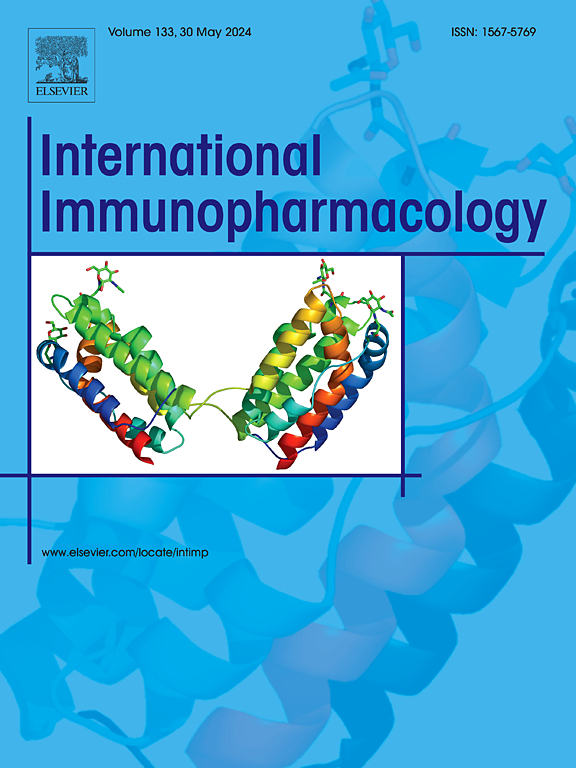Exploring the role of Mitoferrin-1 in Ferroptosis and mitochondrial damage in acute ischemic stroke
IF 4.8
2区 医学
Q2 IMMUNOLOGY
引用次数: 0
Abstract
The pathogenesis of acute ischemic stroke (AIS) is complex, with limited therapeutic options available during the acute phase. Therefore, investigating the underlying mechanisms of AIS is critical. Ferroptosis has been implicated in AIS-induced damage; however, its precise molecular mechanisms remain elusive. In this study, we explored the role of Mitoferrin-1 (Mfrn1) in AIS using a combination of in vitro and in vivo models, including RNA sequencing, RNA interference (RNAi), Adeno-associated virus (AAV9) injection, gene overexpression, and ferroptosis detection. Our results demonstrated that Mfrn1 expression, mitochondrial iron levels, mitochondrial injury, and ferroptosis were significantly increased in AIS models. Knockdown of Mfrn1 attenuated ferroptosis and oxygen-glucose deprivation/reperfusion (OGD/R)-induced injury, whereas overexpression of Mfrn1 had the opposite effect. Similarly, silencing Mfrn1 decreased mitochondrial iron accumulation and injury, while its overexpression exacerbated both. In middle cerebral artery occlusion/reperfusion (MCAO/R) rats, silencing Mfrn1 suppressed ferroptosis, reduced AIS-related injury, lowered mitochondrial iron levels, and mitigated mitochondrial damage. These findings suggest that Mfrn1 exacerbates AIS damage by promoting mitochondrial iron accumulation and injury. This study highlights Mfrn1 as a potential therapeutic target for AIS.

探讨Mitoferrin-1在急性缺血性脑卒中中凋亡和线粒体损伤中的作用。
急性缺血性脑卒中(AIS)的发病机制是复杂的,在急性期可用的治疗选择有限。因此,研究AIS的潜在机制至关重要。铁质下垂与ais引起的损伤有关;然而,其精确的分子机制仍然难以捉摸。在本研究中,我们采用体外和体内相结合的方法,包括RNA测序、RNA干扰(RNAi)、腺相关病毒(AAV9)注射、基因过表达和铁沉检测,探讨了Mitoferrin-1 (Mfrn1)在AIS中的作用。我们的研究结果表明,在AIS模型中,Mfrn1表达、线粒体铁水平、线粒体损伤和铁下垂显著增加。Mfrn1的下调可减轻铁下沉和氧葡萄糖剥夺/再灌注(OGD/R)诱导的损伤,而Mfrn1的过表达则具有相反的作用。同样,沉默Mfrn1可以减少线粒体铁的积累和损伤,而其过表达则加剧了这两者。在大脑中动脉闭塞/再灌注(MCAO/R)大鼠中,沉默Mfrn1抑制铁上落,减少ais相关损伤,降低线粒体铁水平,减轻线粒体损伤。这些发现表明Mfrn1通过促进线粒体铁积累和损伤而加剧AIS损伤。本研究强调Mfrn1是AIS的潜在治疗靶点。
本文章由计算机程序翻译,如有差异,请以英文原文为准。
求助全文
约1分钟内获得全文
求助全文
来源期刊
CiteScore
8.40
自引率
3.60%
发文量
935
审稿时长
53 days
期刊介绍:
International Immunopharmacology is the primary vehicle for the publication of original research papers pertinent to the overlapping areas of immunology, pharmacology, cytokine biology, immunotherapy, immunopathology and immunotoxicology. Review articles that encompass these subjects are also welcome.
The subject material appropriate for submission includes:
• Clinical studies employing immunotherapy of any type including the use of: bacterial and chemical agents; thymic hormones, interferon, lymphokines, etc., in transplantation and diseases such as cancer, immunodeficiency, chronic infection and allergic, inflammatory or autoimmune disorders.
• Studies on the mechanisms of action of these agents for specific parameters of immune competence as well as the overall clinical state.
• Pre-clinical animal studies and in vitro studies on mechanisms of action with immunopotentiators, immunomodulators, immunoadjuvants and other pharmacological agents active on cells participating in immune or allergic responses.
• Pharmacological compounds, microbial products and toxicological agents that affect the lymphoid system, and their mechanisms of action.
• Agents that activate genes or modify transcription and translation within the immune response.
• Substances activated, generated, or released through immunologic or related pathways that are pharmacologically active.
• Production, function and regulation of cytokines and their receptors.
• Classical pharmacological studies on the effects of chemokines and bioactive factors released during immunological reactions.

 求助内容:
求助内容: 应助结果提醒方式:
应助结果提醒方式:


